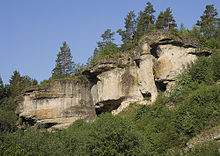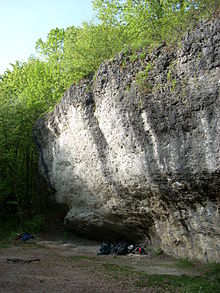Northern Franconian Jura climbing area

The Northern Franconian Jura climbing area is one of the best-developed climbing areas in the world with over 10,000 routes on more than 1,000 massifs and towers . The climbing area is located in Franconian Switzerland and the Hersbrucker Alb between the cities of Nuremberg , Bamberg , Bayreuth and Amberg . This is where the first hook was cemented in and red point climbing had its roots.
The climbing rocks consist mainly of sedimented limestone from deposits of the shallow sea in the time of the White Jura about 161 to 150 million years ago.
Due to the many perforated rocks and overhangs, the Northern Franconian Jura is one of the most important extra-alpine climbing areas . The Action Directe route , first climbed by Wolfgang Güllich , has long been considered the most difficult free climbing route in the world. Currently, the route is expected supernova of Alexander Megos represent the most difficult route in the climbing area. Due to the firm, grippy rock, you can already take routes of III. Climb vertically.
Routes that climbers from all over the world make a pilgrimage to the Franconian region are called Sautanz , Magnet , Stonelove , Wall Street and Action Directe . All are representative of an era of the red dot movement that originated there and triggered a real climbing fever. Important climbing areas are the Trubachtal , the Rodenstein , the Wiesenttal , the Leinleitertal , the Püttlachtal , the Aufseßal and many other valleys.
Climbing areas
Northern part
This part comprises the entire area north of the A 70 and south of the A 70 the areas along the B 22 to Hollfeld with the following sub-areas:
- Wattendorf with Kemitzenstein
- Stübig and Burglesau with the Great Stübigen Tower and the Burglesauer Wall
- Würgau with the Nuremberg Tower
- Steinfeld with Steinfelder Tower, Samestase, Steinfelder Wall and Jura Wall
- Paradise valley with desert stone and yellow wall
- Treunitz with the Treunitzer climbing garden, Treunitzer Wand and Kuhkirchner Wand
- Hollfeld with Kuhleutner wall
- Kleinziegenfelder valley with Holzgauer Wand, Roter Wand, Diebesloch, Klinge and Rolandfels
- Bear Valley
- Zillertal
Northwest part
The region comprises the area west of the Heiligenstadt line in Upper Franconia - Streitberg , bounded to the south by the B 470 with the following sub-areas:
- Burggrub and Oberngrub
- Frankendorfer climbing garden
- Streitberg and Muggendorf
- Matterhorn wall
- Schauertal tower
- Streitberger shield
- Leinleitertal near Veilbronn
- Deep dishes
Northeast part
The region comprises the area east of the Heiligenstadt – Streitberg line, bounded to the south by the B 470 with the following sub-areas:
- Püttlachtal
- Upper Wiesent valley between Behringersmühle and Waischenfeld
- Aufseßal
- Ailsbach valley
- Area around Pottenstein (Upper Franconia)
- Weihersbachtal
Southwest part

The region comprises the area south of the Ebermannstadt - Pottenstein (Upper Franconia) line to Graefenberg and west of the A 9 with the following sub-areas:
- Gößweinstein
- Allersdorf and Stadelhofen
- Graisch, Leienfels, Bärnfels and Soranger
- Stierberg , Leupoldstein and Betzenstein with the Stierberger Gemsenwand, Münchser Wand and Dreistaffelfels
- Spies
- Naifertal and surroundings
- Hiltpoltstein
- Großenoher valley
- Todsfelder Tal (with brittle wall)
- Obertrubach and the upper Trubachtal with Richard-Wagner-Fels, Zehnerstein and Hartelstein
- Between Wolfsberg and Hammerbühl
- Plateau near Sorg, Dörfles and Affalterthal with Western Wall and Signalstein
- Lower Trubachtal and Mostvieler Tal with Egloffsteiner Gemsenwand and Mostvieler climbing block
- Zaunsbachtal
- Schlehental and Wichsenstein
- Burggaillereuth
- Röthelfels and surroundings
- Walberla and Ehrenbachtal
Southeast part
The region includes the area east of the A9 in the triangle Pegnitz - Velden - Königstein with the sub-areas
- Pegnitz and Flembach valleys
- Plech
- Krottenseer Forest
Here climbing history was written with Chasin 'the Trane (IX +), Wallstreet (XI-) and Action Directe (XI). They were the hardest ways of their time.
- Koenigstein
- Bärnhof and Engelthal
- Hartenstein
- Between Velden and Enzendorf
- Neuhaus
Southern part
The region comprises the area east of the A 9 and south of Velden down to the Lauterachtal with the sub-areas:
- Lauterachtal
- Lichtenegg and Haunritz
- Etzelbachtal (Lehenhammertal)
- Förrenbachtal
- Hirschbachtal
- Black fire
- Between Eschenbach and Artelshofen
- Sittenbachtal
- Gotzenberg
- Schnaittach
- Ammerthal
- Neukirchen
- Illschwang
Zone regulation to protect nature
Many of the rocks in the Northern Franconian Jura climbing area are designated as nature reserves or natural monuments , some of which are also part of FFH areas . There is also a Franconian Switzerland Nature Park . To protect nature from excessive exposure to climbers and to preserve sensitive ecosystems, a so-called zone regulation was drawn up between the DAV , IG Climbing , nature conservationists and the responsible authorities from 1993 onwards . This includes the classification of each individual rock (with larger rocks also individual sections) in a certain category:
- Zone 1: quiet zone, general climbing ban
- Zone 2: Climbing on existing routes is permitted, but opening up new routes is prohibited
- Zone 3: Climbing is generally permitted, including the development of new tours outside the vegetation zones
In addition, individual rocks are closed completely or for the breeding season (usually from early February to mid or late June) due to breeding birds, especially eagle owls and peregrine falcons , or particularly sensitive plants.
literature
- Kurt Albert : Fight Gravity - Climbing in the Frankenjura, tmms-Verlag, Korb 2005, ISBN 3-930650-15-0
- Sebastian Schwertner: Climbing Guide Frankenjura Volume 1 , Panico Verlag, 9th edition 2016, ISBN 978-3-95611-050-4
- Sebastian Schwertner: Climbing Guide Frankenjura Volume 2 , Panico Verlag, 10th edition 2016, ISBN 978-3-95611-051-1
- Bernhard Thum: Topoführer Frankenjura , Bernhard Thum Verlag, 8th edition 2010, ISBN 978-3-932064-03-6 .
Individual evidence
- ↑ https://www.frankenjura.com/klettern/news/artikel/1060
- ↑ Zoning concept on the IG Climbing website







